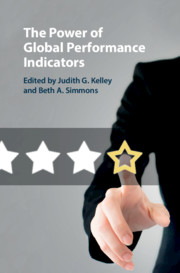Book contents
- The Power of Global Performance Indicators
- The Power of Global Performance Indicators
- Copyright page
- Contents
- Figures
- Tables
- Contributors
- Preface
- 1 Introduction
- Part I Ratings, Rankings, and Regulatory Behavior
- Part II The Normative Influence of Ratings and Rankings
- Part III Beyond and Within State
- Part IV Skeptical Voices
- 11 Third-Party Policymakers and the Limits of the Influence of Indicators
- 12 The Millennium Development Goals and Education
- 13 Global Performance Indicators: Themes, Findings, and an Agenda for Future Research
- Index
- Chapter 3: Appendices
- Chapter 4: Appendices
- Chapter 5: Appendix
- Chapter 6: Appendix
- Chapter 7: Appendix
- Chapter 8: Appendix
- Chapter 10: Appendix
- Chapter 11: Appendix
- Chapter 12: Appendix
- References
12 - The Millennium Development Goals and Education
Accountability and Substitution in Global Indicators
from Part IV - Skeptical Voices
Published online by Cambridge University Press: 28 February 2020
- The Power of Global Performance Indicators
- The Power of Global Performance Indicators
- Copyright page
- Contents
- Figures
- Tables
- Contributors
- Preface
- 1 Introduction
- Part I Ratings, Rankings, and Regulatory Behavior
- Part II The Normative Influence of Ratings and Rankings
- Part III Beyond and Within State
- Part IV Skeptical Voices
- 11 Third-Party Policymakers and the Limits of the Influence of Indicators
- 12 The Millennium Development Goals and Education
- 13 Global Performance Indicators: Themes, Findings, and an Agenda for Future Research
- Index
- Chapter 3: Appendices
- Chapter 4: Appendices
- Chapter 5: Appendix
- Chapter 6: Appendix
- Chapter 7: Appendix
- Chapter 8: Appendix
- Chapter 10: Appendix
- Chapter 11: Appendix
- Chapter 12: Appendix
- References
Summary
Precise international metrics and assessments may induce governments to alter policies in pursuit of more favorable assessments according to these metrics. In this paper, we explore a secondary effect of Global Performance Indicators (GPIs): Insofar as governments have finite resources and make trade-offs in public goods investments, a GPI that precisely targets the provision of a particular public good may cause governments to substitute away from the provision of other, related, public goods. We argue that both the main effect of the GPI (on the measured public good) and this substitution effect vary systematically based on the domestic political institutions and informational environments of targeted states. Specifically, we contend that both the main and substitution effects of GPIs should be largest for governments that are least accountable (opaque and non-democratic) and should be smallest for those that are most accountable. We illustrate the logic of these arguments using a formal model and test these claims using data on primary and secondary enrollment rates across 114 countries. We find that countries substitute toward primary (which is targeted by the Millennium Development Goals) and away from secondary (which is not), and that these effects are mitigated as accountability rises.
Keywords
- Type
- Chapter
- Information
- The Power of Global Performance Indicators , pp. 375 - 408Publisher: Cambridge University PressPrint publication year: 2020



